

Vol. 39 (Number 48) Year 2018. Page 16
Irlanda Jacqueline MARIDUEÑA-MACANCELA 1; Erika Jadira ROMERO-CARDENAS 2; Richard RAMIREZ-ANORMALIZA; 3 Mayra D’ARMAS-REGNAULT 4
Recibido: 14/06/2018 • Aprobado: 29/07/2018 • Publicado 29/11/2018
ABSTRACT: The price of cocoa has generated concern in small farmers dedicated to the cultivation of this fruit, which has led to the search for ventures that contribute to the family economically. The objective of this work is to make known the interest of the farmers to produce handmade chocolate. Qualitative and quantitative methods were used, through a survey of 10 research questions, applied to 140 farmers in La Garganta Campus. The results expressed that the majority of farmers recognize that the price of cocoa is not significant, which has led to the process of cultivation as raw material for the production of homemade chocolate, demanding the need to know the improvements in terms of preparation and presentation of the product for sale. |
RESUMEN: El valor del cacao ha generado preocupación en los pequeños agricultores dedicados al cultivo de este fruto, lo que ha originado la búsqueda de emprendimientos que aporten a la economía familiar. El objetivo del presente trabajo es dar a conocer el interés de los agricultores en elaborar el chocolate artesanal. Se utilizaron los métodos cualitativos y cuantitativos, se aplicó una encuesta de 10 preguntas, a 140 agricultores del Recinto La Garganta. Los resultados demuestran que la mayoría de los agricultores reconoce que el precio del cacao no es significativo, lo cual ha direccionado al proceso de su cultivo como materia prima para la elaboración del chocolate artesanal, demandando la necesidad de conocer las mejoras en cuanto a la preparación y presentación del producto para la venta. |
Cocoa is an extraordinary fruit with which chocolate is made in its different presentations. Ecuador is the largest distributor of fine cocoa and aroma in the world, its immense flavour and aroma are unique, recognized worldwide has represented the interest of land owners to grow it, That is to say, this fruit is cultivated in great proportions in spacious grounds as in small spaces due to the factors and environmental.
This fruit shows an exquisite taste and aroma, contains a great nutritive value in carbohydrates, fats, proteins and minerals. On the other hand, cocoa is linked to the culture, tradition, economy and food of Ecuador.
Its origin goes back to the era of the Mayan civilization, who was the pioneer in consuming this fruit, later; it was the Aztecs who elaborated the so-called "xocoatl" drink. The old Mexicans prepared the cocoa seeds in a similar way to what are still made at present to take the chocolate (GODIVA, 2018).
At the beginning of the nineteenth century, Ecuador perceived the great rise of cocoa as a result of technological and at the same time, industry contributed in the area of cocoa, the invention of machinery capable of cleaning, toasting, grinding, pressing and refining the grain in a different way to the one that had been processed. This process allowed that several types of chocolate products could be obtained from the grain (ANECACAO, 2015).
The chocolate needs its flavour by the concentration of the cacao, since to a greater percentage, greater colour, aroma and flavour. Its colour is of dark hue, knowing it with the name of dark or black, its sweet or bitter flavour is adjusted according to the concentration of cocoa and sweetener. Undoubtedly, chocolate is one of the most appreciated treats worldwide, especially in European countries, and its demand is focused on the special taste. There are various varieties and changes in texture, flavour and presentation for the production of chocolate, industrial or artisan manufacture (Franco, Oñatibia & Martínez, 2013).
Today, chocolate is a product accessible to all. The shops sell a variety of products and figures in chocolate. However, not all people know how to recognize and rate the accuracy of good chocolate.
In Ecuador, artisanal chocolate is made by several groups dedicated to the harvest of this fruit and whose purpose is to generate income in their family economy, which is why they produce a product of excellent quality for the delight of the client's palate and in this way Income to generate family income. The families of small farms dedicated to this activity mostly make homemade chocolate and distribute it in their locality. (Rousseau, 2015)
Among the factors that lead small farmers to the production of artisanal chocolate are: (a) do not count on large land to cultivate cocoa in large proportions, so the sale is made in pounds, which is not significant to much effort and dedication; (b) they do not have economic resources for the maintenance and production of cocoa; and (c) the cost of fruit today, since it is $ 187 per quintal, that is, only $ 1.87 per pound.
The consumption of chocolate produces positive effects in the reduction of the blood pressure of the people who consume it, lowering cholesterol and improving the sensitivity to insulin because its raw material, that is to say, cocoa is one of the foods with greater Content of flavonoids, which are antioxidants that eliminate cancer cells (Balboa et al, 2015).
Research published in the Journal of the American Medical Association says that a reduction in blood pressure would reduce the risk of death from a heart attack by 8%. However, it is observed that chocolate is high in fat and calories and therefore should avoid consuming excess product.
Hence the importance of black or artisan chocolate, because it is more beneficial to the body, since its active ingredient comes from cacao and this could be a food that helps prevent cancer and prolong life expectancy (Zhang et al, 2013).
Bitter Chocolate is a very healthy product, which offers many health benefits, since it is a stimulant food based on its content in slightly nutritious carbohydrates rich in mineral salts, potassium, iron, sodium, copper and calcium (Wilson & Hurst, 2015). On the other hand, this ex excellent treat for the heart since it decreases the cario-vascular risk. Also, bitter chocolate strengthens brain functions and memory (Romero et al, 2016)
According to "Oxidative Medicine and Cellular Longevity", dark or bitter chocolate improves blood circulation and helps to improve endothelial function, increasing blood flow, that is, it is a potent health product And contains no milk (Andújar et al, 2012) . As stated earlier, dark chocolate has no milk, so it is Ideal for use as a base for people who can not consume milk or its derivatives.
In Ecuador small artisan producers conformed by family groups that are dedicated to the harvest of the cacao and continue with the elaboration of the artisanal chocolate.
To mention, the Kallari brand made up of indigenous families make the artisanal chocolate and have reached a level of recognition due to their techniques of cultivation of the raw material (Coral et al, 2016).
According to research by the University of Copenhagen in 2008, dark or bitter chocolate reduces appetite, so people who tasted the product felt much more satisfied compared to those who ate milk chocolate.
Small-scale cocoa farmers in Ecuador nowadays present a variety of problems in the family economy due to the lack of economic resources and the sources of labour. This has come to change their status as farmers to become entrepreneurs who aim their interests in the production of artisanal chocolate and thereby get ahead with their production of handmade chocolate (Eagappan & Sasikumar, 2014).
This innovative initiative acquired by the owners of small farms has changed their perception, acquiring the firmness of harvesting the cocoa and at the same time making the artisanal chocolate in order to market it and to improve their family economic situation.
For Pillco (2016), a planting technician for the artisanal processing of cocoa, he decided to take advantage of the cocoa plantations of a family farm in Naranjal town, applying his knowledge in the production of bitter chocolate chips to be dissolved, either in a litter or a cup of Water or milk.
For Irene Villacís, who has dedicated 68 years to the elaboration of artisanal chocolate, she mentions that the tradition of the 'Chocolate ambateño' obeys to the quality and the purity of the product, since the pure cocoa without mixtures, attracts to the buyers by its aroma (Líderes, 2016).
On the other hand, artisanal chocolate is important in the following: gastronomic product that contains a lot of food potential; economic product and community outreach; craft entrepreneurship and increase in the family economy.
Traditionally, Ecuador is a major cocoa producer and is internationally recognized as the country that provides more than 60% of the world's production of "fine aroma" cocoa, a raw material for the manufacture of fine chocolates.
The profitability of artisanal chocolate as a sustainable undertaking that differentiates the value of the raw material is what has represented the owners of farms that grow cacao, improving their income and strengthening the family union, since in the In most cases the preparation and sale of homemade chocolate is done in the family (Gobierno Provincial del Guayas, 2016).
According to the need of many farmers came the importance of using cocoa as raw material for the production of handmade chocolate and in this way give the opening to form mini-family businesses dedicated to this activity.
The Ecuadorian government, aware of the potential offered by cocoa, decided to boost the entrepreneurship of the producing communities, such as: Cocoa Village in the town of Archidona, Eco-Cacao Center in Tena, and the Cocoa Garden in Arosemena Tola.
The Ecuadorian company Pacari, dedicated to the elaboration of artisan chocolate, is recognized worldwide because its brand produces organic cocoa quality products and that those who make it are part of the value chain.
The importance of making homemade chocolate in Ecuador has taken great prestige taking as an example Santiago Peralta, who is considered as the "best homemaker chocolate of the world” (elEconomista.es, 2016).
The production and sale of handmade chocolate generates great social and environmental responsibility at the time of making the chocolate because its elaboration is different from the factory chocolate.
The article 291 of Plan of the good life Objective 2, mention that "Sponsoring equality, cohesion, inclusion and social and territorial equity, in diversity” (Senplades, 2014).
Equal recognition of the rights of all individuals implies the consolidation of equality policies that avoid exclusion and promote social and political coexistence. The challenge is to advance towards full equality in diversity, without exclusion, to achieve a dignified life, with access to health, education, social protection, specialized care and special protection (Objective 2).
Hence, overcoming poverty must be the dominant aspect that must prevail as a factor of relevance to eliminate old systems that impede the proper development of Good Living, in such a way as to achieve the reduction of the extreme poverty of the Ecuadorian population.
On the other hand, it is important to consider that at present the Ecuadorian economy is based on the extraction of its natural resources and is vulnerable to indecision as a consequence variant effects on the economy.
This process is developed based on sequential operations of the cocoa seed that will be used to make artisanal chocolate, such as:
1. Harvesting the fruit. The ripe fruits of the cocoa should be collected and this process should be considered every 3 to 4 weeks in order to avoid ripening of the product. Afterwards the break of the shell is made to extract the cocoa in slime, which be glued to the cob.
The ripe fruits of the cocoa should be collected and this process should be considered every 3 to 4 weeks in order to avoid ripening of the product. Afterwards the break of the shell is made to extract the cocoa in slime, which must be glued to the cob (ANECACAO, 2016)
It is important to set aside the ears according to colour and size to avoid mixing grain diversity. The characteristics and flavour of chocolate are represented by the diversity of cocoa.
Figure 1
Harvesting the fruit

2. Fermentation. It is a process whose purpose is to remove the pulp that encloses the cocoa beans, which reduce the chemical agents that cause understanding and the bitter and astringent cocoa, because they are deployed in the sun and air in a period of 5 to 7 days to drain and dry, which increases the flavour intensity of the fruit and remove the almonds (MAGAP, 2012). The state of fermentation is generally done using drawers where the cocoa mass is placed for 24 to 36 hours before aerating it so that the fermentation is uniform. Also, the fermentation of cocoa promotes the mutations within the grains that produce the formation of the colour and aroma preceding the chocolate.
Figure 2
Fermentation of chocolate
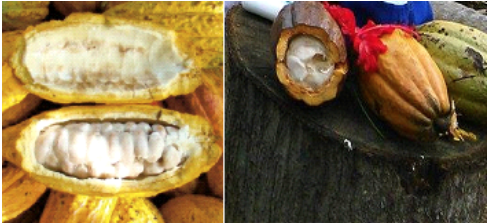
3. Stripped. The cocoa is degummed by sliding the fingers of the hands without mixing with the central vein of the ear. It is important for this step; the seeds are extracted from the fruit, which must be considered that the time of this step should be short so as not to affect the fermentation process.
Figure 3
Stripped of cacao
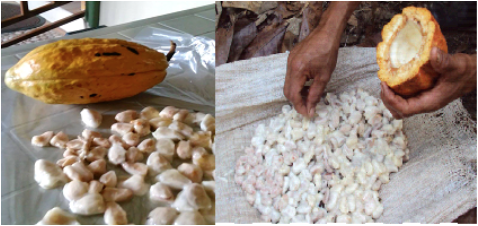
4. Washing the cocoa. After the fermentation, washing is carried out, which allows the removal of mucilage residues that may remain in the cocoa fruits, reducing the risk of mold growth. However, the national fruits are never washed, since their grains are transferred directly to the dried (Chiriboga Vega, 2015).
Figure 4
Washing the cocoa

5. Drying cocoa. Crude cocoa spreads in the soil exposing them to the sun for the space of 1 week in order to achieve its dry and firm state.
Figure 5
Drying cocoa
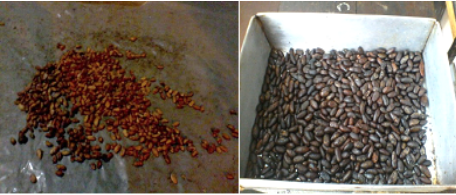
6. Roasted cacao. Toasting is done to remove the peel from the grain. In this stage a strong roasting is required so that the roasting is correct. Handmade chocolate made by small farmers usually do so manually using a container in which the cocoa nut is placed and it is toasted at a temperature of 110 ° C and is done for 15 to 20 minutes since there is no abundance of the product. The main purpose of drying is to reduce the saturation percentage below 8% to avoid contamination with fungi during hoarding.
Figure 6
Roasted cacao
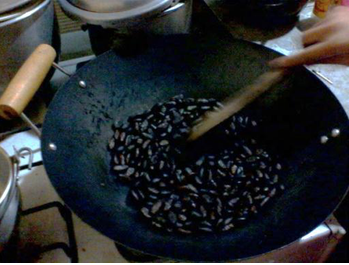
7. Cocoa husking. The husking is the result of the separation of the fruit with the shell that is attached to it, which is done using a small squeeze or tum manually using a fan, in such a way that the shells are dragged by the air.
Figure 7
Cocoa husking
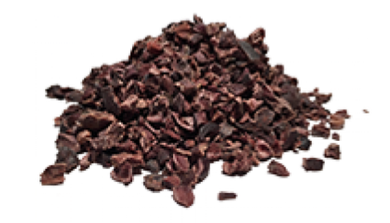
8. Cocoa grinding. In this process of milling, when considering small quantities of cocoa the traditional tool for the small farmer is to use a homemade mill through which he will perform the action of 5 to 6 times, in order to achieve that the product is transformed into a fluid paste. That is to say, it reaches a uniform, compact and smooth consistency known as the cocoa liquor, thus constituting the raw material for the production of dark or bitter chocolate, which is very delicious and required by many households due to its process if natural.
Figure 8
Cocoa grinding
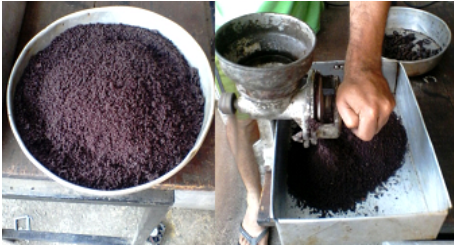
9. Temperate. From this bitter chocolate the pastes are formed, for which the cocoa melts and is cooled three times to obtain a better resistance to heat, preferably at low temperature and for the lapse of 10 minutes.
This process will provide the characteristic shine of the chocolate and will prevent the fats from separating. If desired, sugar can be added to change its taste, but it must be processed from the ground to the point of losing the granulated sugar, after which the liquid chocolate is poured into the molds for baking for 10 minutes and can being compact and delicious before its commercialization and sale (CAOBISCO/AEC/FCC, 2014).
It is important to emphasize that the smell and flavor of cocoa is combined with the sector or region where it is cultivated. Therefore, the National Association of Cacao Exporters of Ecuador (ANECACAO, 2013) establishes the description of cocoa (ANECACAO, 2016).
10. Moulding of cacao. Once the homemade chocolate is made, it is placed in molds according to its weight. Specifically, large or small round molds are used and are placed at a temperature of 5ºC.
11. Presentation of homemade chocolate. The presentation of handmade chocolate may vary according to the economic conditions of the manufacturer. Generally, the wrapper is made of aluminum foil or lollipop paper and is sold as a large tablet or as a candy.
The present investigation had as support a survey with a format of 10 questions addressed to 140 people who live in La Garganta precinct, on the Milagro road, dedicated to the elaboration of artisanal chocolate.
It was considered a simple random sample and the descriptive, qualitative and quantitative methods, considering the pertinence of successful conclusions in accordance with the research problematic. In this research work 140 people, 116 men and 24 women participated. The average age of the respondents is detailed as follows:
Table 1
Average age of participants
Options |
Quantity |
Percentage |
18-25 |
18 |
13 |
26-40 |
90 |
64 |
41-50 |
32 |
23 |
As an important part of this work, it was verified the area of cocoa production in La Garganta Precinct, which describes:
Table 2
Area cocoa production
Options |
Quantity |
Percentage |
1 Hectare |
32 |
23 |
5 Hectares |
78 |
56 |
10 Hectares |
30 |
21 |
The present analysis was obtained from 140 people, mostly owners of small farms, who were surveyed to show the reasons why this group of people is engaged in the elaboration of artisanal chocolate that allows them.
Regarding the price of cocoa, 94% of farmers indicated that the price of cocoa is not so paid and for this reason they do not get enough income to continue their production. See Table 3.
Table 3
Farmers’ opinions
Options |
Quantity |
Percentage |
Yes |
8 |
6 |
No |
132 |
94 |
The low price of cocoa affects the family economy since only 1% of respondents indicated that their economic status is stable. Nevertheless, 69% indicated to be with economic problems and that much depends on the sale of the cacao, nevertheless this product at the present time does not have good price in the market, which prevents to have incomes that allow him to advance in his production. See Table 4.
Table 4
The family economy
Options |
Quantity |
Percentage |
Very good |
2 |
1 |
Good |
42 |
30 |
Regular |
78 |
56 |
Bad |
18 |
13 |
The results show the farmers' interest in learning how to make chocolate, since 134 of the respondents gave an affirmative answer, that is to say, that 96% totally agreed to acquire the knowledge in the elaboration of the artisanal chocolate using the own raw material, which will be representative for their family economy. See Table 5.
Table 5
Interested in learning how to make chocolate
Options |
Quantity |
Percentage |
Yes |
134 |
96 |
No |
6 |
4 |
As for the willingness of farmers to associate with small cocoa producers to form a mini-company that produces homemade chocolate, 71% of respondents expressed their interest in associating among small cocoa producers in order to boost the production of artisanal chocolate and thus generate family income. With the conviction mostly the family economy will change with the production of artisanal chocolate using the production of cocoa from your own farm. See Table 6.
Table 6
Producers accept to have an association
Options |
Quantity |
Percentage |
Yes |
100 |
71 |
No |
40 |
29 |
In this aspect, 83% of the 140 respondents indicated that they are in complete agreement, that is, they demonstrate safety in the economic improvement they would have with the elaboration of artisanal chocolate, considering that they have their own production of cocoa. See Table 7.
Table 7
Changes in family economy
Options |
Quantity |
Percentage |
Yes |
116 |
83 |
No |
24 |
17 |
The opinion of farmers about the benefits of being an entrepreneur in the production of chocolate and its varieties, it is shown below in Table 8. In this part, a number of options were considered and 39% of the respondents said that starting as an entrepreneur would have several benefits such as open credit in state and private banks. In the same way, they would have recognition of the artisan product since they feel motivated and prepared for its elaboration. Of course, all this will be reflected in the reactivation of the family economy. See Table 8.
Table 8
Benefits with the entrepreneurship of homemade chocolate
Options |
Quantity |
Percentage |
Open credit |
14 |
10 |
Recognized product |
28 |
19 |
Stable economic |
46 |
32 |
All of them |
56 |
39 |
This question related to the level of acceptance do you think the artisanal chocolate of the mini-company would have, 77% of those involved in this survey indicated that they would actually have community acceptance and that it would be on a mid-level scale that is, considering that there are several groups that are dedicated to the elaboration of artisanal chocolate. In addition, their desire is to continue training related to this product so that the mini-companies have the welcome of the whole community not only the sector of the Garganta, but all surrounding areas. See Table 9.
Table 9
Level of acceptable of homemade chocolate
Options |
Quantity |
Percentage |
High |
20 |
14 |
Medium |
108 |
77 |
Low |
12 |
9 |
In this question related to the types of products that could be made with chocolate, some alternatives were presented, and the respondents selected more of them. Thus, 55% mentioned that they would devote themselves exclusively to the production of chocolate bars. Likewise, 27% indicated that they would like to dedicate themselves to making the chocolates. Therefore, the result had a variable since the sample that was taken was of 140. See Table 10.
Table 10
Kind of products made with chocolate
Options |
Quantity |
Percentage |
Chocolate in bar |
90 |
55 |
Chocolates |
44 |
27 |
Others |
30 |
18 |
As for the knowledge about production mechanism has been used for the production of handmade chocolate, 49% of the people involved in this research stated that they have knowledge in the elaboration of homemade chocolate, with 51% ignoring the topic. However, they are predisposed to be trained to have greater knowledge and thus to advance in their new enterprise.
Finally, 66% of respondents indicated that they do not have government assistance despite the fact that the reactivation of the family economy is immersed in Goal 2 of the National for Good Living in Ecuador.
The research results point out the importance that the small farmers of La Garganta precinct offer to the cocoa plant as a specific raw material for the production of artisanal chocolate. The following aspects were considered:
1. Establish governmental lines that benefit all cocoa producers, in accordance with the social inclusion established in the Constitution of the Republic of Ecuador, through the Ministry of Agriculture and Livestock Aquaculture and Fisheries to generate the economic recovery of families The cocoa farmers, in order to reduce the poverty of small cocoa farmers in this sector of the city of Milagro, province of Guayas.
They added that the help has the big producers of cocoa and so they have to find ways to generate income for their family.
2. To form chocolate entrepreneurship associations for the benefit of families who own small farms.
3. To develop seminars for the elaboration of chocolate and its derivatives, with the aim of having a good acceptance in the Ecuadorian market.
4. It is of the utmost importance that the Ministry of Aquaculture and Aquaculture and Fisheries manage the due importance so that it benefits this retail sector in order to generate the economic reactivation of this group of people, allowing them to live with dignity.
Andújar, I; Recio, M; R, Giner & Ríos, J. (2012). Cocoa Polyphenols and Their Potential Benefits for Human Health. Oxidative Medicine and Cellular Longevity, 1-23. doi:10.1155/2012/906252
ANECACAO (2016). Estadísticas de Exportación. Asociación Nacional de Exportadores de Cacado. Obtenido de http://www.anecacao.com/index.php/es/estadisticas/estadisticas-actuales.html
ANECACAO (2015). Historia del Cacao. Asociación Nacional de Exportadores de Cacao. Obtenido de http://www.anecacao.com/index.php/es/quienes-somos/historia-del-cacao.html
Balboa, T.; López, E.; León, L.; Pérez, R. (2015). Chocolate and Health-Related Quality of Life: A Prospective Study. Journal Plos, 1-11. doi: 10.1371/journal.pone.0123161
CAOBISCO/AEC/FCC. (2014). Cacao en Grano: Requisitos de Calidad de la Industria del Chocolate y del cacao.
Chiriboga Vega, M. (2015). Pequeñas economías - Reflexiones sobre la agricultura familiar campesina. Quito, Ecuador: www.fao.org/publications.
Coral, Carmen; Chávez, María; Martínez, Iván; Ledesma, Gloria. (2016). Kallari Emprendimiento Indígena en el Ecuador. ResearchGate, 1-24.
Eagappan, K., & Sasikumar, S. (2014). Cardio porotective effect of dark chocolate components: Mechanisms of actions. Cardiology and Angiology: An International Journal, pp. 163-173.
elEconomista.es. (11 de 12 de 2016). El 'mejor chocolate del mundo' llega de Ecuador y apuesta por la calidad y el comercio justo. El Economista, pág. 1.
Franco, R.; Oñatibia, A. O; Martínez, E. (2013). Health Benefits of Methylxanthines in Cacao and Chocolate. Nutrients, 5(10), 4159-4173.
Gobierno Provincial del Guayas (2016). Guía turística del Guayas. Ruta del Cacao. Obtenido de http://www.guayas.gob.ec/turismo/rutas-turisticas/ruta-del-cacao
GODIVA (2018). The History of Chocolate: The Mayans and Aztecs. Obtenido de https://www.godivachocolates.co.uk/the-history-of-chocolate-mayans-aztecs.html
Líderes, R. (01 de 08 de 2016). El chocolate es el negocio familiar por más de 70 años. Obtenido de http://www.revistalideres.ec/lideres/chocolate-negocio-familia-ambato-emprendedores.html
MAGAP (2012). SENAE pase a producción ARES. Ministerio de Agricultura y Ganadería Acuacultura y Pesca. Obtenido de http://www.agricultura.gob.ec/senae-pase-a-produccion-ares/#
Miesse, M. (03 de 2014). http://healthylivingmadesimple.com/dark-chocolate-cocoa-theyre-good-2/. Obtenido de http://healthylivingmadesimple.com/dark-chocolate-cocoa-theyre-good-2/
Pillco, E. (23 de 10 de 2016). Tradición e innovación en chocolates artesanales . El Tiempo, pág. 1.
Romero, É.; Fernández, M.; Macías, J.; Zúñiga, K. (2016). Producción y comercialización del cacao y su incidencia en el desarrollo socioeconómico del cantón Milagro. Ciencia UNEMI, 9(17), 56 - 64.
Rousseau, S. (2015). The Role of Organic and Fair Trade Labels when Choosing Chocolate. Food Quality and Preference, 44, 92-100.
Senplades (2014). Estrategia Nacional para la Igualdad y la Erradicación de la pobreza. Secretaría Nacional de Planificación y Desarrollo. Quito, Pichincha, Ecuador.
Wilson, Philip K ; Hurst, W Jeffrey . (2015). Chocolate and Health: Chemistry, Nutrition and Therapy . Cambridge: The Royal Society of Chemistry.
Zhang, Zhizhong; Xu, Gelin; Liu, Xinfeng. (2013). Chocolate intake reduces risk of cardiovascular disease: Evidence from 10 observational studies. International Journal of Cardiology, 168 (6), 5448–5450.
1. Centro de Recursos para el Aprendizaje y la Investigación, Universidad Estatal de Milagro, Ecuador. Magister en Administración y Dirección de Empresas. jmariduenam@unemi.edu.ec
2. Facultad de Ciencias Administrativas y Comerciales, Universidad Estatal de Milagro, Ecuador. Magister en Administración y Dirección de Empresas. eromeroc@unemi.edu.ec
3. Facultad de Ciencias de la Ingeniería, Universidad Estatal de Milagro, Ecuador. Doctor en Administración y dirección de Empresas. rramireza@unemi.edu.ec
4. Facultad de Ciencias de la Ingeniería, Universidad Estatal de Milagro, Ecuador. Doctora en Administración y dirección de Empresas. mdarmasr@unemi.edu.ec